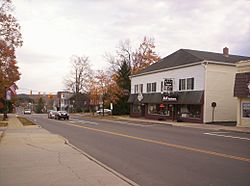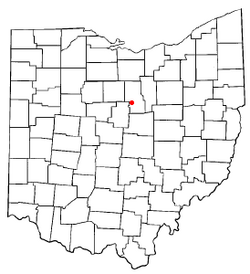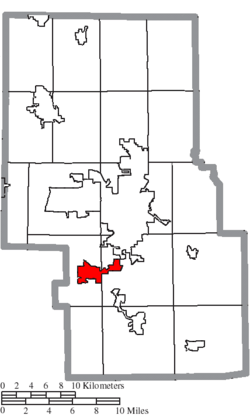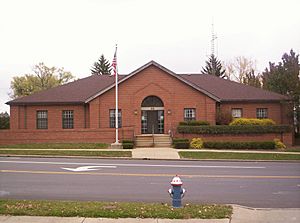Lexington, Ohio facts for kids
Quick facts for kids
Lexington, Ohio
|
|
|---|---|
|
Village
|
|

West Main Street in downtown Lexington in 2007
|
|

Location of Lexington, Ohio
|
|

Location of Lexington in Richland County
|
|
| Country | United States |
| State | Ohio |
| County | Richland |
| Township | Troy and Washington |
| Founded | 1812 |
| Area | |
| • Total | 4.08 sq mi (10.56 km2) |
| • Land | 4.07 sq mi (10.55 km2) |
| • Water | 0.00 sq mi (0.01 km2) |
| Elevation | 1,184 ft (361 m) |
| Population
(2020)
|
|
| • Total | 4,848 |
| • Density | 1,190.57/sq mi (459.72/km2) |
| Time zone | UTC-5 (Eastern (EST)) |
| • Summer (DST) | UTC-4 (EDT) |
| ZIP code |
44904
|
| Area code(s) | 419/567 |
| FIPS code | 39-42994 |
| GNIS feature ID | 2398431 |
| Website | http://www.lexingtonohio.us/ |
Lexington is a small village located in Richland County, Ohio. It sits along the Clear Fork River. In 2020, about 4,848 people lived there. Lexington is part of the larger Mansfield area.
Just outside Lexington, you'll find the Mid-Ohio Sports Car Course. This famous racetrack hosts many exciting events. It has welcomed major car races like the IndyCar Series and the NASCAR Xfinity Series. You can also see motorcycle races and vintage car shows there each year.
Contents
History of Lexington
Founding and Early Days
Lexington was started in 1812 by a man named Amariah Watson Jr. He bought a lot of land in the area to sell to new settlers. In the early 1800s, Lexington had many places for travelers to stay, like taverns and hotels. It also had mills that used water power to grind grain.
Native American tribes like the Delaware, Wyandot, and Mohawk lived in this area first. They built permanent villages and grew crops like corn and beans. They also hunted and gathered food. Amariah Watson Jr. named the village Lexington to honor his father. His father fought in the Revolutionary War, and the first battle was in Lexington, Massachusetts.
Growth and Development
In 1813, Watson built a sawmill powered by water near the Clear Fork River. This mill made it easier to cut wood and helped more settlers move to the area. Businesses used these mills for making wool, sawing wood, and even making drinks.
The first tavern, "Cook's Tavern," opened in 1815. The first grocery store followed in 1825. In 1839, the United States government officially recognized Lexington as a village. By 1850, a railroad line came through Lexington. This helped businesses grow and made travel easier for everyone. Lexington became a busy place where people could find almost anything they needed.
Community Landmarks
The local cemetery is on land that Amariah Watson originally owned. In 1857, the village put a fence around it to make it a safer resting place. A building for the cemetery caretaker was built in 1863. Later, in 1889, a row of maple trees was planted.
The town square in Lexington once had a Civil War Gatling gun. In 1958, the village gave this gun to the Smithsonian Institution in Washington, D.C. You can still see it there today.
The Underground Railroad
A special building called the "Old Stone House" still stands in Lexington. It was built in 1843 and helped many runaway slaves. This house was part of the Underground Railroad, a secret network that helped slaves escape to freedom. People believe slaves were hidden in a secret closet there.
One local, Benjamin Gass, helped 11 or 12 slaves travel in a wagon to another township. From there, they continued their journey to Canada. Other families in Lexington also helped hide slaves on their way to freedom.
Harry F. Smith's Contributions
Harry F. Smith was an important person in Lexington's history. He grew up in the village and created the first outdoor lighting system powered by steam in 1894. Smith later started the Smith Gas Power Company, which became the biggest business in Lexington at the time. He sold it to General Motors in 1918. After he retired, Smith helped create Lexington's water system. He became known as the "Father of the Clear Fork Reservoir" because of his work.
Geography
Lexington is located along the Clear Fork of the Mohican River. The village covers a total area of about 10.56 square kilometers (4.08 square miles). Almost all of this area is land.
Population and People
Population Changes Over Time
Lexington's population has grown quite a bit over the years. Here's how it has changed:
| Historical population | |||
|---|---|---|---|
| Census | Pop. | %± | |
| 1870 | 482 | — | |
| 1880 | 508 | 5.4% | |
| 1890 | 432 | −15.0% | |
| 1900 | 448 | 3.7% | |
| 1910 | 654 | 46.0% | |
| 1920 | 634 | −3.1% | |
| 1930 | 614 | −3.2% | |
| 1940 | 713 | 16.1% | |
| 1950 | 739 | 3.6% | |
| 1960 | 1,311 | 77.4% | |
| 1970 | 2,972 | 126.7% | |
| 1980 | 3,823 | 28.6% | |
| 1990 | 4,124 | 7.9% | |
| 2000 | 4,165 | 1.0% | |
| 2010 | 4,822 | 15.8% | |
| 2020 | 4,848 | 0.5% | |
| Sources: | |||
Life in Lexington (2010)
In 2010, there were 4,822 people living in Lexington. There were about 1,970 households, with many being families. The average household had about 2.41 people. The average age of people in the village was about 39.9 years old. About 25% of the residents were under 18 years old.
Education
The Lexington Local School District serves students in the area. It includes several schools:
- Central Elementary School
- Eastern Elementary School
- Western Elementary School
- Lexington Junior High School
- Lexington High School
In the 2022-2023 school year, a new building opened for both the High School and Junior High, serving grades 7-12. The old school buildings were later taken down. There are plans to build a new school for younger students (Kindergarten through 6th grade) in the future.
Lexington also has a public library. It is a branch of the Mansfield–Richland County Public Library, offering books and resources to the community.
Notable People
Many interesting people have come from Lexington, including:
- John Peter Altgeld, a former governor of Illinois
- Olive San Louie Anderson, a scholar and writer
- R. C. Chambers (1832–1901), a 19th-century businessman
- Creed Brothers, a professional wrestling tag team
- Jamie Feick, a former player in the NBA
- Candice Millard, a well-known writer and journalist
- Hannah Stevens, a 2017 United States National Champion swimmer
- Cade Stover, who won the Ohio Mr. Football in 2018
See also
 In Spanish: Lexington (Ohio) para niños
In Spanish: Lexington (Ohio) para niños


